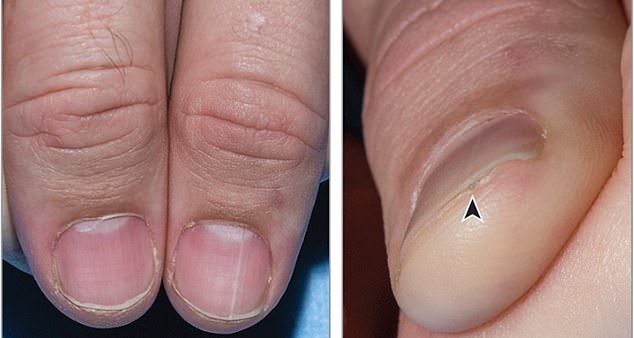Faint lines on your nail could indicate a rare genetic condition that puts you at risk of kidney, skin and eye cancer, new research suggests.
Scientists at the National Institutes of Health (NIH) have found that 88 percent of people with a rare genetic disorder that can lead to cancer have abnormal markings on their nails, including a thin white line that runs the length of the nail.
The genetic disorder, which is believed to run in fewer than 100 American families, increases the chances of developing a rare type of eye cancer, as well as lung, skin and kidney cancer.
Called BAP1 tumor predisposition syndrome, it affects a gene that prevents the body’s cells from growing at a rapid rate and turning into tumor masses.
Most people in the study with abnormal nail markings, such as the thin line running the length of the nail, were found to have a benign tumor.

Of the total number of people diagnosed with a syndrome that predisposes them to cancer, 88 percent had tumors in the nail bed.
The gene also plays a crucial role in repairing DNA damage to cells, which protects against the growth and spread of cancer cells.
Researchers stumbled upon the finding in a study analyzing the gene, called BAP1, for mutations: 41 of 47 people had an abnormal line on a nail, and further analysis found that 39 of them had a benign tumor.
Of the total number of people in the study with confirmed tumor predisposition syndrome, 87.2 percent had nail bed tumors.
Alexandra Lebensohn, a researcher at the National Cancer Institute who helped conduct the study, said: “When asked about nail health during an initial genetic evaluation, one very astute patient reported that she had noticed subtle changes in her nails.
“His comment prompted us to systematically evaluate other participants for nail changes and uncover this new finding.”
The most distinctive finding was a small area of thickened skin under the nail, along with a white band running down the nail, consistent with onychopapilloma, a type of benign tumor.
The tumor is thought to affect the production and distribution of keratin, the type of protein that makes up the nail.
The white lines represent higher levels of keratinization or areas where the nail has been lifted or distorted by the tumor beneath.
Thirty-nine of the 47 study subjects were found to have onychopapilloma, most of them men and mainly on the thumbnail. Onychopapilloma is rare in the general population.
Dr. Edward Cowen, a dermatologist at the NIH’s National Institute of Arthritis and Musculoskeletal and Skin Diseases, said, “We believe that the presence of nail changes suggestive of onychopapillomas on multiple nails should prompt consideration of a diagnosis of nail syndrome. of BAP1 tumor predisposition”.
His research was published in JAMA Dermatology.

The most common type of cancer associated with the genetic syndrome was uveal melanoma, or cancer of the eye.
About 36 percent of people with this genetic disorder have uveal melanoma, a type of cancer that begins in melanin, which produces dark pigments in the middle layer of the eye wall. The uvea includes the iris.
It accounts for only about 5 percent of all melanoma cases in the US.
Barely a quarter of the people People with this syndrome have mesothelioma, according to the NIH. Mesothelioma is an aggressive cancer that develops in the thin layer of tissue that covers most internal organs, and is most commonly seen in the lining of the lungs.
And 10 percent of people with this condition were found to have kidney cancer.
BAP1 tumor predisposition syndrome is rare and still under investigation. Around 70 families in the US They are known to have the genetic mutation that puts them at increased risk of cancer.
Most BAP1-related cancers tend to be more aggressive and strike earlier in life.
In cases of malignant mesothelioma, the age of onset in predisposed people is 55 years, compared to 72 years for people without that predisposition.
At the same time, several studies have reported that patients with a BAP1 mutation have a seven-fold higher overall survival rate than those without genetic predisposition.

